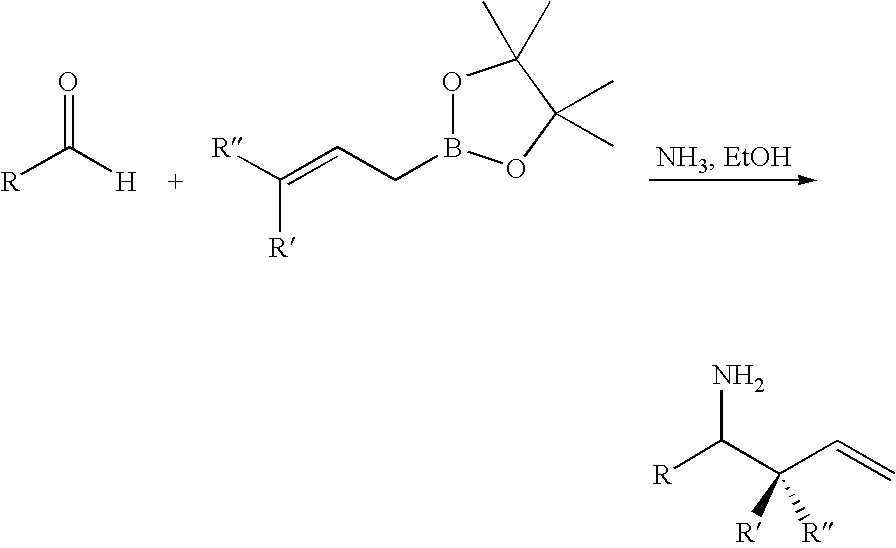Methods of preparing secondary carbinamine compounds with boronic acids
a carbinamine compound and boronic acid technology, applied in the preparation of amino compounds, organic compounds/hydrides/coordination complexes, physical/chemical process catalysts, etc., can solve the problem of no general method for direct synthesis of amines from ammonia, and achieve the effect of simple and efficient, moderate to excellent yield
- Summary
- Abstract
- Description
- Claims
- Application Information
AI Technical Summary
Benefits of technology
Problems solved by technology
Method used
Image
Examples
example 1
General Procedure for the Allylation of Aldehydes with Allylboronic Acid in the Presence of Ammonia
[0056]A solution of ammonia (ca. 7N in MeOH, 0.75 mmol, ca. 10 equiv.) was added to the aldehyde (1) (0.5 mmol). The resulting solution was stirred for 15 minutes at room temperature, followed by the addition of a freshly prepared solution of allylboronic acid (2) (2M in MeOH, 0.4 mL, 0.80 mmol) dropwise over 5 minutes. The reaction mixture was subsequently stirred for 1 hour at room temperature. The volatiles were removed in vacuo and the residue re-dissolved in Et2O (15 mL). Aqueous HCl (1N, 15 mL) was then added dropwise to the residue. The biphasic mixture was vigorously shaken, and the layers were separated. The acidic aqueous layer was washed with Et2O (3×15 mL), and made basic by the addition of solid NaOH (ca. 5 g). The aqueous layer was then extracted with CH2Cl2 (3×15 mL). The combined organic extracts were dried with Na2SO4, filtered and concentrated in vacuo to afford the d...
example 2
General Procedure for the Crotylation of Aldehydes with (E) or (Z)-Crotylboronic Acid in the Presence of Ammonia
[0078]A solution of ammonia (ca. 7N in MeOH, 0.75 mmol, ca. 10 equiv.) was added to the aldehyde (1) (0.5 mmol). The resulting solution was stirred for 15 minutes at room temperature, followed by the addition of a freshly prepared solution of either (E) or (Z)-crotylboronic acid (4a) or (4b) (2M in MeOH, 0.4 mL, 0.80 mmol) dropwise over 5 minutes. The reaction mixture was subsequently stirred for 1 hour at room temperature. The volatiles were removed in vacuo and the residue re-dissolved in Et2O (15 mL). Aqueous HCl (1N, 15 mL) was then added dropwise to the residue. The biphasic mixture was vigorously shaken, and the layers were separated. The acidic aqueous layer was washed with Et2O (3×15 mL), and made basic by the addition of solid NaOH (ca. 5 g). The aqueous layer was then extracted with CH2Cl2 (3×15 mL). The combined organic extracts were dried with Na2SO4, filtered ...
example 3
General Procedure for the Rhodium-Catalyzed Addition of Aryl and Alkenylboronic Acids to Aldehydes in the Presence of Ammonia
[0087]A saturated solution of ammonia in 1,4-dioxane (2 mL) was added to the aldehyde (6). To the resulting solution was added freshly prepared boronic acid (8) (1.0 mmol) and Rh(acac)(CO)2 (12.9 mg, 0.05 mmol). Distilled water (0.4 mL) was then added to the solution and the reaction mixture was heated to 80° C. in a sealed tube for 16 h. The reaction mixture was then cooled to room temperature and the volatiles were removed in vacuo. The residue was dissolved in CH2Cl2 (20 mL) and washed with saturated aq. NaHCO3 (10 mL). The organic layer was dried (Na2SO4), filtered and concentrated in vacuo to afford a yellow oil, which was then subjected to silica gel chromatography (EtOAc / hexanes / Et3N) to afford the carbinamine (8). In some cases, the resulting carbinamine (8) was treated with HCl (1.0 Min Et2O) to afford the corresponding hydrochloride salt. The salt wa...
PUM
| Property | Measurement | Unit |
|---|---|---|
| temperature | aaaaa | aaaaa |
| temperature | aaaaa | aaaaa |
| temperature | aaaaa | aaaaa |
Abstract
Description
Claims
Application Information
 Login to View More
Login to View More - R&D
- Intellectual Property
- Life Sciences
- Materials
- Tech Scout
- Unparalleled Data Quality
- Higher Quality Content
- 60% Fewer Hallucinations
Browse by: Latest US Patents, China's latest patents, Technical Efficacy Thesaurus, Application Domain, Technology Topic, Popular Technical Reports.
© 2025 PatSnap. All rights reserved.Legal|Privacy policy|Modern Slavery Act Transparency Statement|Sitemap|About US| Contact US: help@patsnap.com



